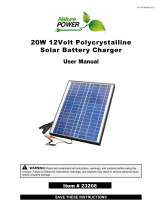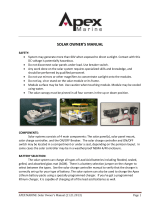
18
19
SOLAR 101: GOAL ZERO makes it easy to recharge your gear from the sun – we didn’t
invent solar power, we perfected it. Some things to keep in mind when recharging your
gear with solar power:
i. Solar panels don’t store power from the sun, they collect it.
We teach you to COLLECT – STORE – USE, which is the best way to utilize solar power to
recharge your gear. COLLECT the sun’s energy with a solar panel. STORE the power in a
recharger. USE the recharger to power your gear, day or night. If you’re really a diehard, you
can plug your gear directly into the junction box located on the back of our NOMAD Solar
Panels to recharge from the sun.
ii. Not all solar charge times are created equal.
Most solar panel manufacturers calculate their recharge times with the following equation:
Device Watt Hours/Solar Panel Watts = Solar Recharge Times. So theoretically, a 13 watt
solar panel would recharge a 50 watt-hour recharger in 3.84 hours (50/13 = 3.84) – and
this is the number you could find in marketing material for a solar panel. However, in order
to standardize results across all manufacturers, these tests are completed in laboratory
settings. The truth is, on a good, sunny day, you’ll receive about 65-85% of your solar panel’s
rated wattage, and this is how the engineers at GOAL ZERO calculate the solar recharge
times you see on our packaging.
iii. Solar works, even in overcast conditions.
Solar panels utilize IR, UV, and visible rays from the sun that can penetrate through clouds.
Although the efficiency of the solar panel will decrease in cloudy conditions, you’ll still be
collecting valuable power from the sun.
iv. Keep away from shade and windows.
Although you should seek out the shade on sunny days, your solar panels will collect
more power when fully exposed to the sunlight. Windows also have a habit of decreasing
efficiency. So keep those panels outside and in the bright sunlight.
v. Proper alignment works wonders.
Keeping your solar panel angled toward the sun can dramatically increase solar efficiency.
Set it up and let Mother Nature do the rest.
Warranty & Contact
LIMITED WARRANTY
This LIMITED WARRANTY from GOAL ZERO LLC (“GOAL ZERO”) warrants to the original consumer
purchaser that this GOAL ZERO product will be free from defects in workmanship and material under
normal consumer use during the applicable warranty period identified in Paragraph 2, below, subject
to the exclusions set forth in Paragraph 5, below. The foregoing provisions state GOAL ZERO’s entire
liability, and your exclusive remedy, for any breach of warranty, express or implied. GOAL ZERO will not
assume, nor authorize any person to assume for it, any other liability in connection with the sales of GOAL
ZERO products.
WARRANTY PERIOD
The warranty period for GOAL ZERO lead acid batteries(whether purchased on a stand-alone basis or as
part of another product) is One Hundred and Eighty (180) days.
The warranty period for GOAL ZERO lithium battery based Yeti products and Boulder solar panels is two
(2) years.
The warranty period for all other GOAL ZERO products and components is one (1) year from the date of
original purchase by the original consumer
A sales receipt from the original consumer purchase, or other reasonable documentary proof, is required
in order to establish the start of the warranty period. If you completed the online GOAL ZERO Product
Registration Form within thirty (30) days after purchasing your product, that registration can also
establish the start date of the warranty period (but warranty coverage is not conditioned upon such
registration).
REMEDY
GOAL ZERO will, at its option, (1) repair the product at no charge, using new or refurbished replacement
parts, or (2) exchange the product with a product that is new or which has been manufactured from new
or serviceable used parts and is at least functionally equivalent to the original product. A replacement
product/part assumes the remaining warranty of the original product or ninety (90) days from the date of
replacement or repair, whichever provides longer coverage for you. When a product or part is exchanged,
any replacement item becomes your property and the replaced item becomes GOAL ZERO’s property.
LIMITED TO ORIGINAL CONSUMER BUYER
This warranty is not transferable to any subsequent owner of a GOAL ZERO product.

















